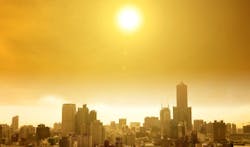6 Causes of Urban Heat Islands and 4 Ways to Offset Them
Urban heat islands are frequently cited as a reason to install a cool roof, but the heat island effect is actually caused by a number of other factors in addition to dark-colored roofs. Reflective roof surfaces can play a key role in reducing the heat island effect, but a multifaceted approach that accounts for other contributing factors will go furthest toward reducing the impact on your building.
This is how urban heat islands are created—and what you can do about it.
6 Things that Create Urban Heat Islands
The urban heat island phenomenon “exists in areas with a lot of densely placed buildings and paved surfaces that absorb heat from the sun, causing the area to be several degrees hotter than rural or surrounding areas,” explain Jeff Steuben, executive director of the Cool Roof Rating Council (CRRC), and Sarah Schneider, CRRC’s deputy director.
The resulting rise in outside air and surface temperatures creates hotter indoor air temperatures, which could make your occupants uncomfortable, stress your HVAC system with extra demand and increase your energy bills.
Some of the factors that contribute to heat island formation include:
1. Paved and impermeable surfaces.
“Paved over surfaces, such as roads and parking lots, can absorb solar radiation as heat,” explain Steuben and Schneider. “Additionally, these surfaces are typically impermeable, which means that water runoff is redirected to the stormwater system rather than being absorbed by plants or water bodies that help cool the area through evapotranspiration and evaporation.”
2. Dark surfaces.
Dark roofs absorb more energy into the building as heat, hence the boom in cool roof adoption. But it’s not just roofs absorbing the heat—blacktop absorbs the sun just as well, and neither surface reflects much solar radiation, so they get hotter than lighter-colored surfaces.
3. Thermal mass.
“Buildings contain a lot of thermal mass, which means they store a lot of heat during the day and are slow to release the heat overnight,” Steuben and Schneider say.
[On topic: Where to Start When Your Building is Ready for Solar Energy]
4. Lack of vegetation.
“Plants and trees create shade and cool the air through evapotranspiration,” explain Steuben and Schneider. But areas that are dominated by paved surfaces have little room for green space.
5. Waste heat.
Mechanical air conditioning exhausts heat into the environment around the building, directly adding to the problem.
6. Changing climate.
Steuben and Schneider cite the more extreme heat waves in urban areas, especially ones in northern regions, as a factor that contributes to urban heat island formation. Urban heat islands also exacerbate the changes in the climate, so the problem feeds on itself.
4 Ways to Offset the Heat Island Effect
Local tracking of urban heat islands is typically done by cities or community organizations, Steuben and Schneider explain. But there are still plenty of actions building owners can take to reduce their individual contribution to the phenomenon.
1. Check with your local jurisdiction
See what they’re already doing, such as adopting a newer version of the building code or conducting community outreach. They may even offer rebates for implementing some heat island mitigation technologies.
BUILDINGS Podcast
Carlisle Roofing Series #2: Roof Gardens
Vegetated roofs aren’t just beautiful—they’re valuable tools for managing stormwater, reducing the urban heat island effect, and providing more usable space for building occupants. Listen now >>
2. Look at your own building
Any improvement you can get a rebate for will naturally be a priority. Then start looking at other strategies you can implement, especially the ones that will yield additional dividends beyond just mitigating the urban heat island effect.
For example, if you need to repave your parking lot or walkways anyway, think about spending a little more upfront to install permeable pavement. Permeable pavement will allow water runoff to flow through it, where it will be absorbed by plants or bodies of water that help cool the area.
3. Reflective roofing
Coatings and retrofits are another area where one project can deliver multiple benefits. A reflective roof that absorbs less sun than conventional roofs reduces the surface temperature of the roof. This reduces the roof’s contribution to the local heat island but also makes it easier and cheaper to keep the building cool enough.
“The more reflective a roof is, the more effective it will be in reducing the surface temperature of the roof and heat gain into the building,” explain Steuben and Schneider. “More reflective can mean whiter and brighter, but reflective roofing isn’t limited to white products. Innovations in ‘cool colors’ result in products that look the same to our eyes but reflect a greater amount of infrared heat.”
Prototypes of these colors tested at the Lawrence Berkeley National Laboratory show reflective roofing in royal blue, chocolate brown, terracotta and even black delivering reflectivity ratings that are two to 10 times higher than their non-reflective counterparts, even though the colors look the same to the naked eye.
[Learn more: Heat Island Effect: What You Need to Know]
4. Research products
In the meantime, investigate products that are currently on the market. The Cool Roof Rating Council maintains a stringent rating process that tests roofing products for solar reflectance (the solar radiation reflected away from the roof) and thermal emittance (how efficiently the roof sheds absorbed heat).
Its Rated Products Directory lists around 3,000 roofing products, along with their solar reflectance and thermal emittance values and their Solar Reflectance Index score, a measure that combines the other two values into a 0-100 rating.
You won’t be able to reverse your area’s urban heat island by yourself, but taking steps to mitigate its impact on your building (and your building’s impact on maintaining the heat island) will deliver energy, air conditioning and financial savings to your building while you do your part to reduce the urban heat island effect.
Two handpicked articles to read next:
About the Author
Janelle Penny
Editor-in-Chief at BUILDINGS
Janelle Penny has been with BUILDINGS since 2010. She is a two-time FOLIO: Eddie award winner who aims to deliver practical, actionable content for building owners and facilities professionals.

